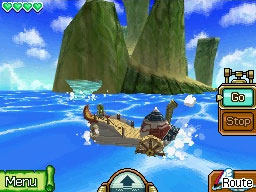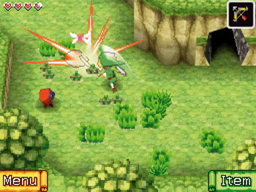Legend of Zelda – Phantom Hourglass

My view is that portable versions of major titles – or portable parts in major series, as in this case – are usually just watered-down versions of the real thing; as if it wasn’t possible to actually make a good portable game to begin with. Luckily, Nintendo’s major series have managed to avoid this fate more often than they have succumbed to it, but there are some bad examples out there as well. I’m not sure about Phantom Hourglass, as it seems a lot like a watered-down (no pun intended) version of Wind Waker, but if any Zelda game could actually maintain some substance with a lot less content, that would be it.
Phantom Hourglass doesn’t bring anything new to the table in terms of narrative and we are served a variation of the collect-somethings-to-enter-the-evil-something – story present in every Zelda game since games had in-game stories. The fact that it doesn’t really offer anything on top of this makes it rank in the lower end of the zelda-narrative-spectrum as far as I’m concerned, but that spectrum isn’t really wide so I guess it doesn’t matter. What matters slightly more is the presentation.
The DS isn’t made for fully 3D games, so it follows naturally that the game isn’t perfect in this regard. And it is by no means bad – what they have managed to achieve with the limited hardware is incredibly impressive and certain parts, for example the animations, are at least as good as it’s GameCube predecessor. Problem is, it’s not really enough and compared to the other games it’s poorly detailed and not very pretty at all. Which is a shame, really, since there has been several beautiful 2D Zeldas and Phantom Hourglass doesn’t need the third dimension to work.

Continuing into the important part of the game – the design. Phantom Hourglass is conceptually a lot like Wind Waker with the open water and scattered islands, but the perspective and gameplay while on land is more akin to Minish Cap or any other of the 2D Zeldas; played almost exclusively from a top-down view. As stated, the levels are a little more scarce and less interesting than previous games, but still fun to play.
The big change, and seemingly where the bulk of the design time was spent, is in the implementation of the DS-specific controls. You play the game almost exclusively with the DS stylus, from walking and fighting to navigating. Normal commands suffer some precision but the difficulty has been adjusted for this so it’s not really noticeable; what’s more interesting is how the special items are implemented. You can control the boomerang’s exact path, aim in any direction when shooting arrows or sling the hookshot around poles; even the previously superfluous bombchus have an important part in Phantom Hourglass – for once, you really use your entire arsenal regularly. Sadly, the other DS functions – specifically the microphone – aren’t implemented with the same finesse – why would an entire development team think that it would be okay to release a game for a handheld that requires you to shout into the mic on several occasions? even the early DS games offered you a “silent” version.
So is it good enough? it certainly isn’t a bad game, and I have to admit that after this autumn my standards have risen considerably so I might be unreasonably harsh. Phantom Hourglass is well worth playing if you don’t mind taking on epic adventures on portable devices. It’s just that Nintendo has been doing so well with their core franchises lately, and held to the high standards set by the most recent Mario and Zelda titles Phantom Hourglass doesn’t really cut it.